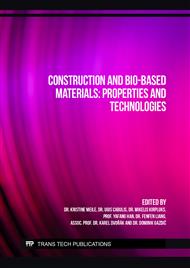[1]
A. A. Alquriaishi & E. M. El-M. Shokir, Experimental Investigation of Miscible CO2 Flooding, Petroleum Science and Technology, 29 (2011) 2005-2012.
DOI: 10.1080/10916461003662976
Google Scholar
[2]
Zhang Baoshou, Gu Qiaoyuan, Zhang Haizu, Zhao Qing, Yin Fenglin, Genesis and Study Significance of High CO2 Content in Carbonate Rocks in Tazhong Area,Tarim Basin, Marine Origin Petroleum Geology,3(2010)70-73.
Google Scholar
[3]
ROSA M, CUE´LLAR-FRANCA, ADISA A, Carbon capture, storage and utilisation technologies: A critical analysis and comparison of their life cycle environmental impacts, Journal of CO2 utilization, 9(2015)82-102.
DOI: 10.1016/j.jcou.2014.12.001
Google Scholar
[4]
ZHAO Xue-hui, HE Zhi-wu, LIU Jin-wen, et al. Research status of CCUS corrosion control technology, Petroleum tubular goods and instruments, 3(2017)1-6.
Google Scholar
[5]
ZHANG De-ping, Pilot test of research and application status of CO2 flooding production technology, Science and technology review,29( 2011) 75-79.
Google Scholar
[6]
YANG Sheng-lai, CHEN Hao, FENG Ji-lei, A brief discussion on some scientific issues to improve oil displacement during gas injection Tarim oilfield, Petroleum Geology and Recovery Efficiency,1(2014)40-44+113.
Google Scholar
[7]
LV Xiang-hong, ZHAO Guo-xian, Tubing and Casing material and corrosion prevention, Petroleum industry Press,(2015).
Google Scholar
[8]
Xue Yan, Research on Corrosion Behavior of Low Cr Corrosion-resistant Materials in Tarim Oilfield, Xi'an: Xi'an Shiyou University, (2010).
Google Scholar
[9]
Q. Wu, Z. Zhang, X. Dong, J. Yang, Corrosion behavior of low-alloy steel containing 1% chromium in CO2 environments, Corros. Sci. 75 (2013) 400–408.
DOI: 10.1016/j.corsci.2013.06.024
Google Scholar
[10]
M.N. Zafar, R. Rihan, L. Al-Hadhrami, Evaluation of the corrosion resistance of SA-543 and X65 steels in emulsions containing H2S and CO2 using a novel emulsion flow loop, Corros. Sci. 94 (2015) 275–287.
DOI: 10.1016/j.corsci.2015.02.013
Google Scholar
[11]
S. Hassani, T.N. Vu, N.R. Rosli, S.N. Esmaeely, Y.-S. Choi, D. Young, S. Nesic, Wellbore integrity and corrosion of low alloy and stainless steels in high pressure CO2 geologic storage environments: An experimental study, Int. J. Greenh. Gas Control 23 (2014) 30–43.
DOI: 10.1016/j.ijggc.2014.01.016
Google Scholar
[12]
S. Guo, L. Xu, W. Chang, M. Lu, Experimental study of CO2 corrosion of 3Cr pipeline steel, Acta Metall. Sin. 47 (2011) 1067–1074.
Google Scholar
[13]
Z. Bai, C. Chen, M. Lu, J. Li, Analysis of EIS characteristics of CO2 corrosion of well tube steels with corrosion scales, Appl. Surf. Sci. 252 (2006) 7578–7584.
DOI: 10.1016/j.apsusc.2005.09.011
Google Scholar
[14]
Bei Wang, Lining Xu, Guozhang Liu, Minxu Lu, Corrosion behavior and mechanism of 3Cr steel in CO2 environment with various Ca2+ concentration, Corros. Sci. 136 (2018) 210–220.
DOI: 10.1016/j.corsci.2018.03.013
Google Scholar
[15]
Yongxin Lu, Hongyang Jing, Yongdian Han, Lianyong Xu, Effect of temperature on the 3Cr low-alloyed steel initial corrosion behavior in CO2 solution, Materials Chemistry and Physics,178 (2016) 160-172.
DOI: 10.1016/j.matchemphys.2016.04.083
Google Scholar
[16]
Yong Hua a, Xiaoqi Yue, Huifeng Liu, et al. The evolution and characterisation of the corrosion scales formed on 3Cr steel in CO2-containing conditions relevant to geothermal energy production, Corros. Sci. 183 (2021) 109342.
DOI: 10.1016/j.corsci.2021.109342
Google Scholar
[17]
Jinyang Zhu a, Lining Xu a,Minxu Lu, et al. Essential criterion for evaluating the corrosion resistance of 3Cr steel in CO2 environments: Prepassivation, Corros. Sci. 93 (2015) 336-340.
DOI: 10.1016/j.corsci.2015.01.030
Google Scholar
[18]
M.B. Kermani, A. Morshed, Carbon dioxide corrosion in oil and gas production-a compendium, Corrosion 59 (2003) 659–683.
DOI: 10.5006/1.3277596
Google Scholar
[19]
D.S. Carvalho, C.J.B. Joia, O.R. Mattos, Corrosion rate of iron and iron–chromium alloys in CO2 medium, Corros. Sci. 47 (2005) 2974–2986.
DOI: 10.1016/j.corsci.2005.05.052
Google Scholar


